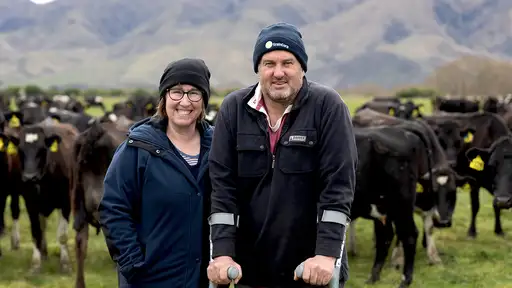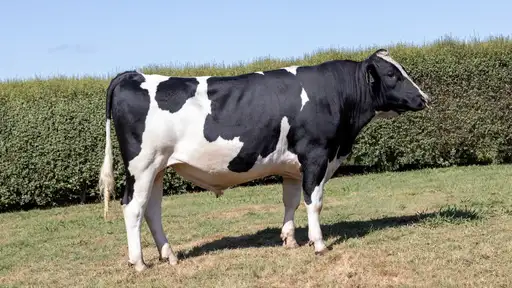
Two seasons ago Callum was so impressed by a trial run of 60 heifers that he’s since stepped-up his purchase plan to grow more dairybee heifers in lieu of Friesian bulls.
The former Young Farmer of the Year (2007), along with his wife Kelly, run an 1100ha sheep and beef operation with Callum’s parents (Roger & Michelle) in Patoka, Hawke’s Bay.
This year Callum is finishing 232 Profit Maker cross dairy heifers, as he brings through a further cohort of 138 rising one-year-old dairy-beef cross heifers.
The 232 rising three-year-old heifers were purchased from the Te Hopai dairy operation in Wairarapa, with an additional 138 younger heifers purchased from a Southern Pastures dairy farm in Canterbury (both sets of heifers were bred from Profit Maker semen, supplied by LIC, to these two dairy operations).
This spring Callum’s farm will send nearly 650 beef animals to the works, one-third of which will be the heifers.
However, sheep are 50% of the operation, and until three years ago the rest of the farm grazed dairy heifers, but a tuberculosis incursion forced a sudden re-think and the farm operation had to change tack.
A beef-finishing operation took the place of dairy grazing, Callum says.
“Initially our new model was to kill 650 bulls each year, ideally at 340kg carcass weight, with about 500 younger bulls as well,” Callum says.
“But we do quite a bit of re-grassing and fencing, I’ve got about 450ha in little 2ha paddocks, with an 8-wire, one hot, no-baton type fence, and it’s a good multi-purpose fence for lambs and for cattle.
“The bulls were making good money, but they’re also pretty good at destroying things. When I was doing my re-grassing, I just didn’t like the damage the bulls were doing. They also like fighting and injuring themselves and each other, hips, legs, you name it.
“So we started looking around at what other options we had. And I started talking with the Absoloms (from Rissington cattle Company) because they’re close-by, and there’s a common connection with our children at the same school.
Rissington Cattle Company supplies Profit Maker, Angus, and Simmental semen and are available through LIC’s (beef) Genetics Catalogue.
“A couple of times I went to their feedlot system they had there, looked at their animals, and was more than interested,” Callum said.
“So Daniel Absolom sowed the seed, suggesting I try the dairy-cross heifers, and he was the connection with Te Hopai (Te Hopai utilised Profit Maker genetics over cows it didn’t wish to breed replacements from).
“It was a good fit,” Callum says.
“They were selling animals in the spring when I needed them, when Iwas killing my bulls. So I purchased the heifers and then we wintered them, and killed them the following spring. it was pretty much 11 months of finishing.
“They did really well, the weight gains were good, I had no deaths. For the first season I only bought 60 heifers from Te Hopai, probably at 330kgs liveweight, and I killed them at 278kg carcass (liveweight equates to 560kg).”
“I kept them in the same system. I ran them at 2.6 to the hectare, and I finished lambs ahead of them. The grass in that system was highpowered with a lot of plantain clover, and I didn’t want the heifers to blow up with bloat in the spring. So I grazed the lambs in front of the heifers in that period to take away the clover.”
Callum said he was happy with the dairy-cross margins: “If you look at FARMAX (a modelling and decision support tool, developed for pastoral farmers), on paper, my cents/kg dry matter for the heifers won’t quite keep up with what the bull does, but to me that’s not the whole story.
“We need to make our margins, but you’ve also got to enjoy what you’re doing, and I’ve got a couple of young kids, 10 and 12, and they’ve got their own little motorbikes and stuff, and if I’m going out to shift bulls they won’t come because they don’t want to be knocked over by a 650kg bull… they get a bit dangerous.
“Whereas the heifers are an absolute joy, such a joy to shift, you open the gate, and they walk through quietly.”
“I’m happy with their growth rates. This year I’m going to work hard to get the best kill rates possible, and kill them on the peak schedule and make the maths on them stack up, get the cents/kg DM up, and I’d quite like to expand it as much aswe can.”




